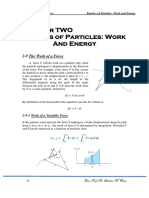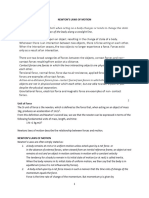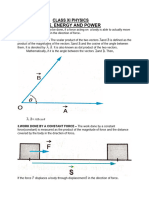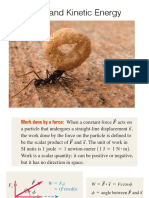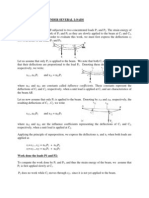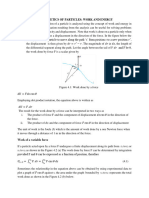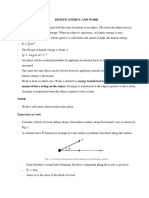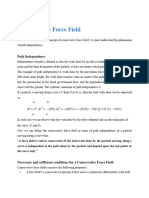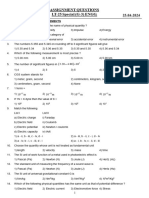week 6. Exp 6
Uploaded by
Timothy Adekanyeweek 6. Exp 6
Uploaded by
Timothy AdekanyeGEC 241-APPLIED MECHANICS Kinetics of particles
WEEK 5
GEC 241- APPLIED MECHANICS II- DYNAMICS
KINETICS OF PARTICLES
The work of a Force
Specifically, a force F will do work on a particle only when the particle undergoes a
displacement in the direction of the force. In the diagram below, the force F causes the particle
to move along the path s from position r to a new position r’, the displacement is then dr = r’ –
between the tails of dr and F is 𝜃𝜃, then the work done by F is a scalar quantity defined by
r. The magnitude of dr is ds, the length of the differential segment along the path. If the angle
𝑑𝑈 = 𝐹 𝑑𝑠 𝑐𝑜𝑠𝜃𝜃 (1)
By definition of the dot product this equation can be written as
𝑑𝑈 = 𝐹. 𝑑𝑟 (2)
component of displacement ds cos 𝜃𝜃 in the direction of the force, or as the product of ds and
This result may be interpreted in one of two ways: either as the product of F and the
the component of force, Fcos 𝜃𝜃, in the direction of the displacement. Note that if 00 ≤ 𝜃𝜃 <
900, then the force component and displacement have the same sense so that the work is
positive, whereas if 900 < 𝜃𝜃 ≤ 1800, these vectors will have opposite sense and therefore
the work is negative. Also dU = 0, or if the force is perpendicular to displacement, since cos 90 0=
0, or if the force is applied at a fixed point in which the displacement is zero.
The unit of work in SI units is the joule (J), which is the amount of work done by a one-newton
force when it moves through a distance of one meter in the direction of the force (1 J = 1 N.m).
DEPT. OF MECHANICAL 26/03/
GEC 241-APPLIED MECHANICS Kinetics of particles
Work of a variable force
to r2 or s1 to s2, the work of force F is determine by integration. Provided F and 𝜃𝜃 can be
If the particle acted upon by the force F undergoes a finite displacement along its path from r 1
expressed as a function of position, then
𝑟2 𝑟2
𝑈1−2 = � 𝐹. 𝑑𝑟 = � (3)
𝐹𝑐𝑜𝑠𝜃𝜃𝑑𝑠
𝑟1 𝑟1
Sometimes, this relation may be obtained by using experimental data to plot a graph of Fcos𝜃𝜃
vs s. then the area under this graph bounded by s1 and s2 represents the total work.
Work of a constant force moving along a straight line
If the force Fc has a constant magnitude and acts at a constant angle 𝜃𝜃 from its straight line
path, then the component of F c in the direction of displacement is always F ccos 𝜃𝜃. The work
done by Fc when the particle is displaced from s1 to s2 is determined in which case
DEPT. OF MECHANICAL 26/03/
GEC 241-APPLIED MECHANICS Kinetics of particles
𝑠2
𝑈1−2 = 𝐹𝑐 𝑐𝑜𝑠𝜃𝜃 � 𝑑𝑠
𝑠1
Or
𝑈1−2 = 𝐹𝑐 𝑐𝑜𝑠𝜃𝜃(𝑠2 − 𝑠1) (3 )
Work of a weight
At an intermediate point, the displacement 𝑑𝑟 = 𝑑𝑥𝒊𝒊 + 𝑑𝑦𝒋𝒋 + 𝑑𝑧𝑘. Since W = -Wj
Consider a particle of weight W, which moves up along the path s from position s1 to position s2.
𝑟2
𝑈1−2 = � 𝐹. 𝑑𝑟 = � (−𝑊𝑊𝑊𝑊) ∙ (𝑑𝑥𝑑𝑑 + 𝑑𝑦𝑊𝑊 + 𝑑𝑧𝑘)
𝑟1
𝑦2
=� −𝑊𝑊𝑑𝑦 = −𝑊𝑊(𝑦2 − 𝑦1 )
𝑦1
Or
𝑈1−2 = −𝑊𝑊∆𝑦 (4)
Thus the work is independent of the path and is equal to the magnitude of the particle’s weight
times its vertical displacement.
Work of a spring force
DEPT. OF MECHANICAL 26/03/
GEC 241-APPLIED MECHANICS Kinetics of particles
If an elastic spring is elongated a distance ds, then the work done by the force that acts on the
attached particle is dU = - Fsds = -ks ds. The work is negative since Fs acts in the opposite sense
to ds. If the particle displaces from s1 to s2, the work of Fs is then
𝑠2 𝑠2
𝑈1−2 = � 𝐹𝑠𝑑𝑠 = � −𝑘𝑠 𝑑𝑠
𝑠1 𝑠1
1 1
𝑈
2 2
= − � 𝑘𝑠2 − 𝑘𝑠1 � (5)
2 2
1−2
A mistake in sign can be avoided when applying this equation if one simply notes the direction
of the spring force acting on the particle and compares it with the sense of direction of
displacement of the particle- if both are in the same sense, positive work results; if they are
opposite to one another, the work is negative.
Principle of work and energy
Consider a particle of mass m acted upon by a force F and moving along a path which is either
rectilinear or curved. Expressing Newton’s second law in terms of the tangential components of
the force and of the acceleration, we write
𝐹𝑡 𝑑𝑣
= 𝑜𝑟 = 𝑚𝑑𝑡
𝑚𝑎𝑡 𝐹𝑡
where 𝑣 is the speed of the particle. Recalling that
𝑣 = 𝑑𝑠/𝑑𝑡, we obtain
𝑑𝑣 𝑑𝑠 𝑑𝑣
𝐹𝑡 = 𝑚 𝑑𝑠 𝑑𝑡 = 𝑚𝑣𝑑𝑠
𝐹𝑡𝑑𝑠 = 𝑚𝑣𝑑𝑣 (6)
1 1
Integrating from A1 where s=s1and v=v1, to A2, where s = s2 and v = v2, we write
𝑠2 𝑣2
� 𝐹𝑡𝑑𝑠 = 𝑚 � 𝑣𝑑𝑣 = 2 𝑚𝑣2 −2 (7)
𝑚𝑣1 2
2
𝑠1 𝑣1
The left-hand member of the above equation represents the work of the force F exerted on the
particle during the displacement from A1 to A2 as indicated, the work is a scalar quantity. The
DEPT. OF MECHANICAL 26/03/
GEC 241-APPLIED MECHANICS Kinetics of particles
expression 𝑚𝑣2is also a scalar quantity; it is defined as the kinetic energy of the particle and is
1
2
denoted by T. We write
𝑇= 𝑚𝑣2
1
2
𝑈1−2 = 𝑇2 − 𝑇1 (8𝑎)
Substituting into (7), we have
which expresses that, when a particle moves from A1 to A2 under the action of a force F, the
work of the force F is equal to the change in kinetic energy of the particle. This is known as the
𝑇1 + 𝑈1−2 = 𝑇2 (8𝑏)
principle of work and energy. Rearranging the terms, we write
Thus, the kinetic energy of the particle at A2 can be obtained by adding to its kinetic energy at
A1 the work done during the displacement from A1 to A2 by the force F exerted on the particle.
Like Newton’s second law from which it is derived, the principle of work and energy applies
only with respect to a newtonian frame of reference. The speed v used to determine the kinetic
energy T should therefore be measured with respect to a newtonian frame of reference.
Since both work and kinetic energy are scalar quantities, their sum can be computed as an
ordinary algebraic sum, the work U1-2 being considered as positive or negative according to the
direction of F. when several forces act on the particle, the expression U 1-2 represents the total
work of the forces acting on the particle; it is obtained by adding algebraically the work of the
various forces.
definition 𝑇 = 1 𝑚𝑣2 that regardless of the direction of motion of the particle the kinetic energy
As noted above, the kinetic energy of a particle is a scalar quantity. It further appears from the
2
is always positive. Considering the particular case when v1 = 0 and v2 = v, and substituting T1 = 0
and T2 = T into eq. (8b), we observe that the work done by the forces acting on the particle is
equal to T. Thus, the kinetic energy of a particle moving with a speed v represents the work
which must be done to bring the particle from rest to the speed v. Substituting
T1 = T and T2 = 0 into eq.(8b), we also note that when a particle moving with a speed v is
brought to rest, the work done by the forces acting on the particle is 2 T. Assuming that no
energy is dissipated into heat, we conclude that the work done by the forces exerted by the
particle on the bodies which cause it to come to rest is equal to T. Thus, the kinetic energy of a
particle also represents the capacity to do work associated with the speed of the particle.
The kinetic energy is measured in the same units as work, i.e., in joules if SI units are used and
in ft/lb if U.S. customary units are used.
Example
1. The 40kg boy in the figure below slides down the smooth water slide. If he starts from
rest at A, determine his speed when he reaches B and the normal reaction the slide
exerts on the boy at this position.
DEPT. OF MECHANICAL 26/03/
GEC 241-APPLIED MECHANICS Kinetics of particles
Solution
𝑇𝐴 + 𝑈𝐴−𝐵 = 𝑇𝐵1
Using the principle of work and energy,
0 + (40(9.81)𝑁)7.5𝑚) = (40𝑘𝑔)𝑣2
2 𝐵
𝑣𝐵 = 12.13 𝑚⁄𝑠
When the boy is at B, the normal reaction N B can be obtained by applying the equation of
motion along the n-axis. Here the radius of curvature of the path is
Power and Efficiency
Power is defines as the time rate at which work is done. In the selection of a motor or engine ,
power is much more important criterion than is the actual amount of work to be performed.
The higher the power of an engine, the faster it completes required task.
The power generated by a machine or engine that performs an amount of work dU within the
𝑑𝑈
time interval dt is
𝑃 = 𝑑𝑡 (9)
𝑑𝑈 𝐹. 𝑑𝑟 𝑑𝑟
If the work dU is expressed as dU = F.dr, then
𝑃 = 𝑑𝑡= 𝑑 = 𝐹.
𝑑𝑡
𝑡
DEPT. OF MECHANICAL 26/03/
GEC 241-APPLIED MECHANICS Kinetics of particles
𝑃 = 𝐹. 𝑣 (10)
Or
The basic unit of power is Watt. Sometime horsepower can be used.
Note that 1 hp = 746 W.
Efficiency of a machine is defined as the ratio of the output of useful power produced by the
𝑝𝑜𝑤𝑒𝑟
machine to the input of power supplied to the machine. Hence,
(11)
𝜀𝜀 =
𝑜𝑢𝑡𝑝𝑢𝑡
𝑝𝑜𝑤𝑒𝑟 𝑑𝑑𝑛𝑝𝑢𝑡
If energy supplied to the machine occurs during the same time interval at which it is drawn,
𝑒𝑛𝑒𝑟𝑔𝑦 𝑜𝑢𝑡𝑝𝑢𝑡
then the efficiency may also be expressed in terms of the ratio.
𝜀𝜀 = 𝑒𝑛𝑒𝑟𝑔𝑦 𝑑𝑑𝑛𝑝𝑢𝑡
Since machines consist of series of moving parts, frictional forces will always be developed
within the machine and as a result, extra energy or power is needed to overcome these forces.
Consequently, power output will be less than power input and o the efficiency f a machine is
always less than 1.
Example:
2. The man in the figure pushes on the 50kg crate with a force of F=150 N. determine the
floor and the crate is 𝜇𝑘 = 0.2. Initially the crate is at rest.
power supplied by the man when t = 4s. The coefficient of kinetic friction between the
Solution
To determine the power developed by the man, the velocity of the 150N force must be
obtained first. Applying the equation of motion,
DEPT. OF MECHANICAL 26/03/
GEC 241-APPLIED MECHANICS Kinetics of particles
Principle of impulse and momentum
Consider a particle of mass m acted upon by a force F. Using he Newton’s second law, the force
𝐹 = 𝑑 (𝑚𝑣)
can be expressed as
𝑑𝑡
where mv is the linear momentum of the particle. Multiplying both sides by dt and integrating
𝐹𝑑𝑡 = 𝑑(𝑚𝑣)
from a time t1 to a time t2, we have
𝑡2
� 𝐹𝑑𝑡 = 𝑚𝑣2 − 𝑚𝑣1
𝑡1
or, transposing the last term,
DEPT. OF MECHANICAL 26/03/
GEC 241-APPLIED MECHANICS Kinetics of particles
𝑡2
𝑚𝑣1 + � 𝐹𝑑𝑡 = 𝑚𝑣2 (12)
𝑡1
The integral is a vector known as the linear impulse, or simply the impulse of the force F during
𝑚𝑣1 + 𝐼𝑚𝑝1−2 = 𝑚𝑣2 (13)
the interval of time considered.
When several forces act on a particle, the impulse of each of the forces must be considered. We
have
𝑚𝑣1 + � 𝐼𝑚𝑝1−2 = 𝑚𝑣2 (14)
If no external force is exerted on the particles or more generally, if the sum of the external
forces is zero, the second term in the above equation vanishes and reduces to
� 𝑚𝑣1 = � 𝑚𝑣2 (15)
which expresses that the total momentum of the particles is considered.
DEPT. OF MECHANICAL 26/03/
GEC 241-APPLIED MECHANICS Kinetics of particles
Example 3
DEPT. OF MECHANICAL 26/03/
GEC 241-APPLIED MECHANICS Kinetics of particles
Example 4
Impulsive motion
A force acting on a particle during a very short time interval that is large enough to produce a
definite change in momentum is called an impulsive force and the resulting motion is called an
impulsive motion. For example, when a baseball is struck, the contact between bat and ball
DEPT. OF MECHANICAL 26/03/
GEC 241-APPLIED MECHANICS Kinetics of particles
takes place during a very short time interval ∆t. But the average value of the force F exerted by
the bat on the ball is very large, and the resulting impulse F ∆t is large enough to change the
sense of motion of the ball.
When impulsive forces act on a particle, this equation holds
𝑚𝑣1 + � 𝐹∆𝑡 = 𝑚𝑣2 (16)
∆t is very small. Non-impulsive forces include the weight of the body, the force exerted by a
Any force which is not an impulsive force may be neglected, since the corresponding impulse F
spring, or any other force which is known to be small compared with an impulsive force.
Unknown reactions may or may not be impulsive; their impulses should therefore be included
as long as they have not been proved negligible. The impulse of the weight of the baseball
considered above, for example, may be neglected. If the motion of the bat is analyzed, the
impulse of the weight of the bat can also be neglected. The impulses of the reactions of the
player’s hands on the bat, however, should be included; these impulses will not be negligible if
the ball is incorrectly hit.
We note that the method of impulse and momentum is particularly effective in the analysis of
the impulsive motion of a particle, since it involves only the initial and final velocities of the
particle and the impulses of the forces exerted on the particle. The direct application of
functions of the time and the integration of the equations of motion over the time interval ∆t.
Newton’s second law, on the other hand, would require the determination of the forces as
In the case of the impulsive motion of several particles, it reduces to
� 𝑚𝑣1 + � 𝐹∆𝑡 = � 𝑚𝑣2 (17)
where the second term involves only impulsive, external forces. If all the external forces acting
on the various particles are non-impulsive, the second term in Eq. (13.36) vanishes and this
equation reduces to Eq. (13.34). We write
� 𝑚𝑣1 = � 𝑚𝑣2 (18)
which expresses that the total momentum of the particles is conserved. This situation occurs,
for example, when two particles which are moving freely collide with one another. We should
note, however, that while the total momentum of the particles is conserved, their total energy
is generally not conserved.
Example 5:
An automobile weighing 4000lb is driven down a 50 incline at a speed of 60mi/h when the
brakes are applied, causing a constant total braking force (applied by the road on the tires) of
1500lb. Determine the time required for the automobile to come to a stop.
Solution
𝑚𝑣1 + � 𝐼𝑚𝑝1−2 = 𝑚𝑣2
𝑚𝑣1 + (𝑊𝑊𝑠𝑑𝑑𝑛50 )𝑡 − 𝐹𝑡 = 0
(4000⁄32.2)(88) + (4000𝑠𝑑𝑑𝑛50)𝑡 − 1500𝑡 =
0
𝑡 = 9.49 𝑠
DEPT. OF MECHANICAL 26/03/
GEC 241-APPLIED MECHANICS Kinetics of particles
Impact
Impact occurs when two bodies collide with each other during a very short period of time,
causing relatively large (impulsive) forces to be exerted between the bodies. The striking of a
hammer on a nail, or golf club on a ball etc are examples of impact loading.
In general, there are two types of impact which are central impact and oblique impact.
Central impact occurs when the direction of motion of mass centers of the two colliding
particles is along a line passing through the mass centers of the particles. This line is called the
line of impact, which is perpendicular to the plane of contact. When the motion of one or both
of the particles make an angle with the line of impact, the impact is said to be oblique impact.
To illustrate the method for analyzing the mechanics of imppact, consider the case involving the
The particles have the initial momenta in which provided (𝑣𝐴)1 > (𝑣𝐵)1 collision will
central impact of the two particles A and B shown in the central impact figure above.
eventually occur. During the collision, the particles must be thought of as deformable or non
opposite deformation impulse ∫ 𝑃𝑑𝑡 on each other. Only at the instant of maximum
rigid. The particles will undergo a period of deformation such that they exert an equal but
deformation will both particles move with a common velocity v, since their relativemotion is
zero.
Afterward a period of restitution occurs, in which case the particles will either return to their
∫ 𝘙𝑑𝑡 pushes the particles apart from one another. In reality, the physical properties of any
original shape or remain permanently deformed. The equal but opposite restitution impulse
restitution, i.e. ∫ 𝑃𝑑𝑡 > ∫ 𝘙𝑑𝑡. Just after separation, the particles will have the final
two bodies are such that the deformation impulse will always be greater than that of
momenta where (𝑣𝐵)2 > (𝑣𝐴)2.
DEPT. OF MECHANICAL 26/03/
GEC 241-APPLIED MECHANICS Kinetics of particles
In most problems, the initial velocities of the particles will be known and it will be necessary to
determine their final velocities. In this regard, the momentum for the system of particles is
conserved since during the internal impulses of deformation and restitution cancel. Hence, we
+
have
�→� 𝑚𝐴 (𝑣𝐴 )1 + 𝑚𝐵 (𝑣𝐵 )1 = 𝑚𝐴 (𝑣𝐴 )2 + 𝑚𝐵 (𝑣𝐵 )2 (19)
In order to obtain a second equation necessary to solve for (𝑣𝐴)2 𝑎𝑛𝑑 (𝑣𝐵)2, the principle of
impulse and momentum must be applied to each particle. For instance, during the deformation
phase for particle A, we have
(20)
For the restitution phase,
(21)
The ratio of the restitution impulse to the deformation impulse is called the coefficient of
restitution, e. from the above equations, this value for particle A is
(22)
Similarly, we can establish e by considering particle B. this yields
(23)
Eliminating the unknown v from the two equations, the coefficient of restitution can be
expressed in terms of the particles’ initial and final velocities as
DEPT. OF MECHANICAL 26/03/
GEC 241-APPLIED MECHANICS Kinetics of particles
(24)
Coefficient of restitution
It states that e is equal to the ratio of the relative velocity of particles’ separation just after
impact to the relative velocity of the particles’ approach just before impact.
Experiments have proved that e varies appreciably with impact velocity as well as with the size
and shape of the colliding bodies. In general e has a value between zero and one.
When e=1, this is called elastic impact. This means that if the collision between two particles is
perfectly elastic, the deformation impulse is equal and opposite to the restitution impulse.
Although in reality, this can never be achieved.
When e=0, the impact is said to be inelastic or plastic. In this case, there is no restitution
impulse so that after collision both particles couple or stick together and move with a common
velocity.
Note that if the impact is perfectly elastic, no energy is lost in the collision whereas if the
collision is plastic, the energy lost during collision is maximum.
DEPT. OF MECHANICAL 26/03/
GEC 241-APPLIED MECHANICS Kinetics of particles
Example 6
DEPT. OF MECHANICAL 26/03/
GEC 241-APPLIED MECHANICS Kinetics of particles
Practice Questions
1. Differentiate between central impact and oblique impact.
2. Differentiate between elastic and plastic impact.
4. If the coefficient of kinetic friction between the 150lb crate and the ground is 𝜇𝑠 =
3. Explain the term “restitution” as related impact.
0.2, determine the speed of the crate when t= 4 s. the crate starts from rest and is
towed by the 100lb force.
5. Determine the coefficient of restitution e between ball A and ball B. the velocities of A
and B before and after the collision are shown
DEPT. OF MECHANICAL 26/03/
You might also like
- ME 230 Kinematics and Dynamics: Wei-Chih WangNo ratings yetME 230 Kinematics and Dynamics: Wei-Chih Wang90 pages
- Kinetics of A Particle: Work and EnergyNo ratings yetKinetics of A Particle: Work and Energy21 pages
- Module 3 Kinetics of A Particle-Work and EnergyNo ratings yetModule 3 Kinetics of A Particle-Work and Energy65 pages
- Chapter TWO Kinetics of Particles: Work and EnergyNo ratings yetChapter TWO Kinetics of Particles: Work and Energy6 pages
- The Work of A Force, The Principle of Work and Energy & Systems of ParticlesNo ratings yetThe Work of A Force, The Principle of Work and Energy & Systems of Particles58 pages
- DYN-04 Kinetics of a Particle Wk 2 2016 - pdfNo ratings yetDYN-04 Kinetics of a Particle Wk 2 2016 - pdf70 pages
- Integrating ( M) With Respect To Displacement: Work and EnergyNo ratings yetIntegrating ( M) With Respect To Displacement: Work and Energy27 pages
- Tlo7 Kinetics of A Particle Work and EnergyNo ratings yetTlo7 Kinetics of A Particle Work and Energy9 pages
- Module 3 Kinetics of Particle Energy Work For TeachingNo ratings yetModule 3 Kinetics of Particle Energy Work For Teaching6 pages
- Revision Notes On Work, Energy and Power For NEET 2024 - Free PDF DownloadNo ratings yetRevision Notes On Work, Energy and Power For NEET 2024 - Free PDF Download15 pages
- Engineering Dynamics: Kinetics of A Particle: Work and Energy100% (1)Engineering Dynamics: Kinetics of A Particle: Work and Energy25 pages
- Work Done by A Variable Force (Vertical Effort) Experiment50% (2)Work Done by A Variable Force (Vertical Effort) Experiment3 pages
- Kinetics of A Particle: Work and Energy Method: Engr. Kristelle Ann V. Ginez, MECENo ratings yetKinetics of A Particle: Work and Energy Method: Engr. Kristelle Ann V. Ginez, MECE37 pages
- Feynman Lectures Simplified 2B: Magnetism & ElectrodynamicsFrom EverandFeynman Lectures Simplified 2B: Magnetism & ElectrodynamicsNo ratings yet
- Understanding Vector Calculus: Practical Development and Solved ProblemsFrom EverandUnderstanding Vector Calculus: Practical Development and Solved ProblemsNo ratings yet
- Math Handbook Formulas Trigonometry by Earl Whitney100% (2)Math Handbook Formulas Trigonometry by Earl Whitney109 pages
- Buy Ebook Cosmogenic Nuclides Principles Concepts and Applications in The Earth Surface Sciences 1st Edition Dunai Tibor J. Cheap Price100% (7)Buy Ebook Cosmogenic Nuclides Principles Concepts and Applications in The Earth Surface Sciences 1st Edition Dunai Tibor J. Cheap Price70 pages
- phy-class-12-most-important-questions-electric-potential-and-capacitanceNo ratings yetphy-class-12-most-important-questions-electric-potential-and-capacitance19 pages
- Sample_of_White_and_Pharoah's_Oral_Radiology_Principles_and_InterpretationNo ratings yetSample_of_White_and_Pharoah's_Oral_Radiology_Principles_and_Interpretation104 pages
- 12th Physics Do You Know Boxes Short Notes English Medium PDF DownloadNo ratings yet12th Physics Do You Know Boxes Short Notes English Medium PDF Download5 pages
- Waldorf Science: A Science News Roundletter100% (1)Waldorf Science: A Science News Roundletter34 pages
- 18 Magnetic Effects of Current Formula Sheets Getmarks AppNo ratings yet18 Magnetic Effects of Current Formula Sheets Getmarks App5 pages
- Advanced Illustration On ElectrostaticsNo ratings yetAdvanced Illustration On Electrostatics13 pages
- An Elementary Construction of The Geometric Algebra - Alan MacdonaldNo ratings yetAn Elementary Construction of The Geometric Algebra - Alan Macdonald7 pages
- Quantum Mechanics 2nd Edition A.S. Davydov - Read the ebook now or download it for a full experience100% (2)Quantum Mechanics 2nd Edition A.S. Davydov - Read the ebook now or download it for a full experience40 pages
- Les Houches Lecture Notes On Moduli Spaces of Riemann SurfacesNo ratings yetLes Houches Lecture Notes On Moduli Spaces of Riemann Surfaces46 pages
- Petar Bosnic Petrus Source of The Future PhysicsNo ratings yetPetar Bosnic Petrus Source of The Future Physics120 pages
- Electrical Manipulation of Semiconductor Spin Qubits Within The G-Matrix Formalism - RemovedNo ratings yetElectrical Manipulation of Semiconductor Spin Qubits Within The G-Matrix Formalism - Removed1 page
- Chapter TWO Kinetics of Particles: Work and EnergyChapter TWO Kinetics of Particles: Work and Energy
- The Work of A Force, The Principle of Work and Energy & Systems of ParticlesThe Work of A Force, The Principle of Work and Energy & Systems of Particles
- Integrating ( M) With Respect To Displacement: Work and EnergyIntegrating ( M) With Respect To Displacement: Work and Energy
- Module 3 Kinetics of Particle Energy Work For TeachingModule 3 Kinetics of Particle Energy Work For Teaching
- Revision Notes On Work, Energy and Power For NEET 2024 - Free PDF DownloadRevision Notes On Work, Energy and Power For NEET 2024 - Free PDF Download
- Engineering Dynamics: Kinetics of A Particle: Work and EnergyEngineering Dynamics: Kinetics of A Particle: Work and Energy
- Work Done by A Variable Force (Vertical Effort) ExperimentWork Done by A Variable Force (Vertical Effort) Experiment
- Kinetics of A Particle: Work and Energy Method: Engr. Kristelle Ann V. Ginez, MECEKinetics of A Particle: Work and Energy Method: Engr. Kristelle Ann V. Ginez, MECE
- Feynman Lectures Simplified 2B: Magnetism & ElectrodynamicsFrom EverandFeynman Lectures Simplified 2B: Magnetism & Electrodynamics
- Understanding Vector Calculus: Practical Development and Solved ProblemsFrom EverandUnderstanding Vector Calculus: Practical Development and Solved Problems
- Math Handbook Formulas Trigonometry by Earl WhitneyMath Handbook Formulas Trigonometry by Earl Whitney
- Buy Ebook Cosmogenic Nuclides Principles Concepts and Applications in The Earth Surface Sciences 1st Edition Dunai Tibor J. Cheap PriceBuy Ebook Cosmogenic Nuclides Principles Concepts and Applications in The Earth Surface Sciences 1st Edition Dunai Tibor J. Cheap Price
- phy-class-12-most-important-questions-electric-potential-and-capacitancephy-class-12-most-important-questions-electric-potential-and-capacitance
- Sample_of_White_and_Pharoah's_Oral_Radiology_Principles_and_InterpretationSample_of_White_and_Pharoah's_Oral_Radiology_Principles_and_Interpretation
- 12th Physics Do You Know Boxes Short Notes English Medium PDF Download12th Physics Do You Know Boxes Short Notes English Medium PDF Download
- 18 Magnetic Effects of Current Formula Sheets Getmarks App18 Magnetic Effects of Current Formula Sheets Getmarks App
- An Elementary Construction of The Geometric Algebra - Alan MacdonaldAn Elementary Construction of The Geometric Algebra - Alan Macdonald
- Quantum Mechanics 2nd Edition A.S. Davydov - Read the ebook now or download it for a full experienceQuantum Mechanics 2nd Edition A.S. Davydov - Read the ebook now or download it for a full experience
- Les Houches Lecture Notes On Moduli Spaces of Riemann SurfacesLes Houches Lecture Notes On Moduli Spaces of Riemann Surfaces
- Electrical Manipulation of Semiconductor Spin Qubits Within The G-Matrix Formalism - RemovedElectrical Manipulation of Semiconductor Spin Qubits Within The G-Matrix Formalism - Removed











